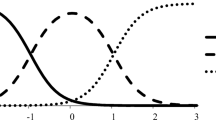Abstract
The aim of this study was to determine gender and age differences and agreement among the reports of adolescent problem behaviour by parents, teachers, and adolescents themselves. For 1,122 11- to 18-year-olds, reports by parents, teachers, and adolescents were obtained. Multivariate regressions were performed to investigate the effect of informant, gender, and age on problem behaviour. Adolescents reported higher levels of problems than parents and teachers for all types of behaviour. Parents reported higher levels of problem behaviour than teachers. Gender differences among informants were dependent on type of problem behaviour. With increasing age, scores of adolescents, parents, and teachers diverged for most types of problems, with larger differences for older adolescents than for younger adolescents. Norms for adolescents need age adjustments for reports by adolescents, parents, and teachers. To obtain a complete view on children’s problem behaviours information from multiple informants and differences among them is needed.
Similar content being viewed by others
References
Achenbach TM (1991) Integrative guide for the CBCL/4–18, YSR, and TRF profiles. University of Vermont Department of Psychiatry, Burlington, VT
Achenbach TM, McConaughy SH, Howell CT (1987) Child/adolescent behavioral and emotional problems: implications of cross-informant correlations for situational specificity. Psychol Bull 101:213–232
Angold A, Costello EJ, Worthman CM (1998) Puberty and depression: the roles of age, pubertal status and pubertal timing. Psychol Med 28:51–61
Bongers IL, Koot HM, van der Ende J, Verhulst FC (2003) The normative development of child and adolescent problem behavior. J Abnorm Psychol 112:179–192
Cole DA, Truglio R, Peeke L (1997) Relation between symptoms of anxiety and depression in children: A multitrait-multimethod-multigroup assessment. J Consult Clin Psychol 65:110–119
Crijnen AAM, Achenbach TM, Verhulst FC (1997) Comparisons of problems reported by parents of children in 12 cultures: Total problems, externalizing, and internalizing. J Am Acad Child Adolesc Psychiatry 36:1269–1277
Faraone SV, Biederman J, Spencer T, Wilens T, Seidman LJ, Mick E, Doyle AE (2000) Attention-deficit/hyperactivity disorder in adults: an overview. Biol Psychiatry 48:9–20
Goldwasser MA, Fitzmaurice GM (2001) Multivariate linear regression analysis of childhood psychopathology using multiple informant data. Int J Methods Psychiatr Res 10:1–10
Keiley MK, Bates JE, Dodge KA, Pettit GS (2000) A cross-domain growth analysis: externalizing and internalizing behaviors during 8 years of childhood. J Abnorm Child Psychol 28:161–179
Lahey BB, Schwab-Stone M, Goodman SH, Waldman ID, Canino G, Rathouz PJ, Miller TL, Dennis KD, Bird H, Jensen PS (2000) Age and gender differences in oppositional behavior and conduct problems: a cross-sectional household study of middle childhood and adolescence. J Abnorm Psychol 109:488–503
Meyer GJ, Finn SE, Eyde LD, Kay GG, Moreland KL, Dies RR, Eisman EJ, Kubiszyn TW,Reed GM (2001) Psychological testing and psychological assessment. A review of evidence and issues. Am Psychol 56:128–165
Nolen-Hoeksema S, Girgus JS (1994) The emergence of gender differences in depression during adolescence. Psychol Bull 115:424–443
Richters JE (1992) Depressed mothers as informants about their children: a critical review of the evidence for distortion. Psychol Bull 112:485–499
Ritsher JE, Warner V, Johnson JG, Dohrenwend BP (2001) Inter-generational longitudinal study of social class and depression: a test of social causation and social selection models. Br J Psychiatry (Suppl) 40:s84–s90
Rubio-Stipec M, Fitzmaurice G, Murphy J, Walker A (2003) The use of multiple informants in identifying the risk factors of depressive and disruptive disorders–are they interchangeable? Soc Psychiatry Psychiatr Epidemiol 38:51–58
Rutter M, Sroufe LA (2000) Developmental psychopathology: concepts and challenges. Dev Psychopathol 12:265–296
Sawyer MG, Baghurst P, Mathias J (1992) Differences between informants’ reports describing emotional and behavioural problems in community and clinic-referred children: a research note. J Child Psychol Psychiatry 33:441–449
Scahill L, Schwab-Stone M (2000) Epidemiology of ADHD in school-age children. Child Adolesc Psychiatr Clin North Am 9:541–555
Seiffge-Krenke I, Kollmar F (1998) Discrepancies between mothers’ and fathers’ perceptions of sons’ and daughters’ problem behaviour: a longitudinal analysis of parent-adolescent agreement on internalising and externalising problem behaviour. J Child Psychol Psychiatry 39:687–697
Silverthorn P, Frick PJ (1999) Developmental pathways to antisocial behavior: the delayed-onset pathway in girls. Dev Psychopathol 11:101–126
Stanger C, Lewis M (1993) Agreement among parents, teachers, and children on internalizing and externalizing behavior problems. J Clin Child Psychol 22:107–115
Van der Ende J (1999) Multiple informants: multiple views. In: Koot HM, Crijnen AAM, Ferdinand RF (eds) Child psychiatric epidemiology. Van Gorcum, Assen, pp 39–52
Verhulst FC, Achenbach TM, van der Ende J, Erol N, Lambert MC, Leung PW, Silva MA, Zilber N, Zubrick SR (2003) Comparisons of problems reported by youths from seven countries. Am J Psychiatry 160:1479–1485
Verhulst FC, Van der Ende J (1992) Agreement between parents’ reports and adolescents’ self-reports of problem behaviour. J Child Psychol Psychiatry 33:1011–1023
Verhulst FC, Van der Ende J (2002) Rating scales. In: Rutter M, Taylor E (eds) Child and Adolescent Psychiatry. Blackwell Publishing, London, pp 70–86
Verhulst FC, Van der Ende J, Ferdinand RF, Kasius MC (1997) The prevalence of DSM-III-R diagnoses in a national sample of Dutch adolescents. Arch Gen Psychiatry 54:329–336
Westerlaak JM, Kropman JA, Collaris JWM (1975) Beroepenklapper. Instituut voor Toegepaste Sociologie, Nijmegen
Zahn-Waxler C (1993) Warriors and worriers:Gender and psychopathology. Dev Psychopathol 5:79–89
Zoccolillo M (1993) Gender and the development of conduct disorder. Dev Psychopathol 5:65–78
Author information
Authors and Affiliations
Corresponding author
Rights and permissions
About this article
Cite this article
van der Ende, J., Verhulst, F.C. Informant, gender and age differences in ratings of adolescent problem behaviour. Europ.Child & Adolescent Psych 14, 117–126 (2005). https://doi.org/10.1007/s00787-005-0438-y
Accepted:
Issue Date:
DOI: https://doi.org/10.1007/s00787-005-0438-y




